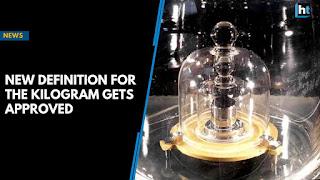Background: After 130 years The Definition of Kilogram
has changed. On the day of “World Metrology Day” The General Conference on
Weights and Measures organised by
“International Bureau of Weights and Measures” (BPIN) which was held at
Paris, France adopt the resolution to redefined the Four out of Seven Base
units such as Kilogram, Kelvin, Mole and Ampere. The proposal was agreed by 60
Countries to assure the
future stability of the SI and open the opportunity for the use of new
technologies, including quantum technologies, to implement the definitions.
1. Why such changes needed ?
Ans: "Using the fundamental constants we observe
in nature as a foundation for important concepts, such as mass and time, means
that we have a stable foundation from which to advance our scientific
understanding, develop new technologies and address some of society's greatest
challenges," said Martin Milton, Director,
International Bureau of Weights and Measures (BIPM).
2. What will happen ?
Ans: The unit of Kilogram joined a bunch of other units such as second, metre, ampere, kelvin, mole and candela that will no longer
be compared with physical objects as standards of reference. The change comes
after nearly 130 years. In 1889 a platinum-iridium cylinder was used to define
how much mass one kilogram represented. Now, a more abstract definition of the
kilogram has been adopted in terms of fundamental constants, namely, the
Planck’s constant H.
3. Historical Prospect:
The definition
of the kilogram for more than 130 years old since 1889 the International Prototype of the Kilogram
(IPK), also called “Le Grand K” a cylinder of a platinum alloy stored at the
International Bureau of Weights and Measures (BIPM) in France, will now be
retired and It will be replaced by the Planck constant -- the fundamental
constant of quantum physics. While the stability of the IPK could only be
confirmed by comparisons with identical copies, a difficult and potentially
inaccurate process, the Planck constant is ready for use everywhere and always.
4. What is Kibble Balance and how it measure ?
Ans: Bryan Kibble at the U.K.’s National Physical Laboratory (NPL), who conceptualized
it in 1975, the Kibble balance is an exquisitely accurate weighing machine.
Like any balance, it is designed to equalize one force with another: In this
case, the weight of a test mass is exactly offset by a force produced when
an electrical current is run through a coil of wire immersed in a
surrounding magnetic field. The surrounding field is provided by a large
permanent magnet system or an electromagnet. The moveable coil, once
electrified, becomes an electromagnet with a field strength proportional to the
amount of current it conducts. When the coil's field interacts with the
surrounding magnetic field, an upward force is exerted on the coil. The
magnitude of that force is controlled by adjusting the current.








No comments:
Post a Comment